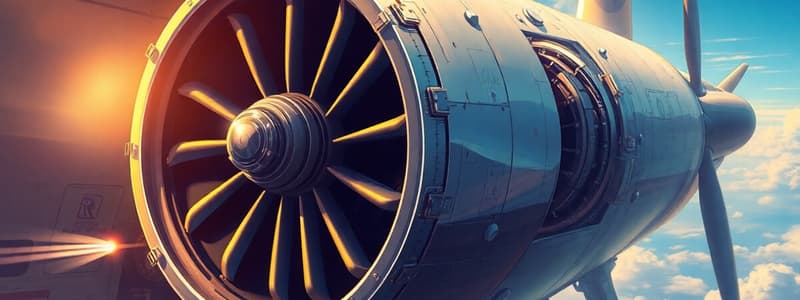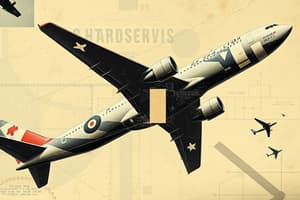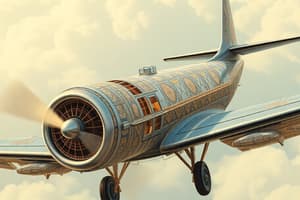Podcast
Questions and Answers
When an airplane yaws to the left, which control surface is primarily responsible for this movement and what is its position?
When an airplane yaws to the left, which control surface is primarily responsible for this movement and what is its position?
- Flaps, extended to increase drag on the right wing.
- Ailerons, with the left aileron deflected upwards and the right aileron downwards.
- Elevator, with both elevator surfaces deflected upwards.
- Rudder, deflected to the left. (correct)
During the power stroke of a reciprocating engine, what energy conversion takes place?
During the power stroke of a reciprocating engine, what energy conversion takes place?
- Mechanical kinetic energy is converted to thermal energy.
- Chemical potential energy is converted to thermal energy, then to mechanical kinetic energy. (correct)
- Electrical energy is converted to mechanical kinetic energy.
- Thermal energy is converted to chemical potential energy.
An aircraft is experiencing unwanted roll. Which control surfaces should the pilot manipulate to correct this, and how should they be moved?
An aircraft is experiencing unwanted roll. Which control surfaces should the pilot manipulate to correct this, and how should they be moved?
- Elevator; move the elevator up or down depending on the direction of the roll.
- Flaps; extend the flaps on the wing opposite the direction of the roll.
- Rudder; deflect the rudder in the opposite direction of the roll.
- Ailerons; move the ailerons in opposite directions (one up, one down). (correct)
If a pilot wants to increase the aircraft's pitch, which control surface should they adjust, and in what direction?
If a pilot wants to increase the aircraft's pitch, which control surface should they adjust, and in what direction?
What is the primary function of the mechanism that connects the piston to the propeller in a reciprocating engine?
What is the primary function of the mechanism that connects the piston to the propeller in a reciprocating engine?
Flashcards
Fuselage
Fuselage
The main body of the airplane, housing passengers and cargo.
Flap
Flap
Hinged control surface on the wing that increases lift.
Aileron
Aileron
Control surface on the wing that controls roll.
Yaw
Yaw
Signup and view all the flashcards
Reciprocating Engine
Reciprocating Engine
Signup and view all the flashcards
Study Notes
- Airplane parts include fuselage, cockpit/cabin, wing, flap, aileron, horizontal stabilizer, elevator, vertical stabilizer, and rudder.
Axes of Rotation
- Vertical axis controls yaw, using the rudder to move right or left.
- Longitudinal axis controls roll, using ailerons that move oppositely.
- Lateral axis controls pitch, using the elevator, which moves both up or down.
Reciprocating Engines
- Also referred to as piston engines or internal combustion engines.
- There are 4 strokes that occur in each cylinder, intake, compression, power, and exhaust
- Chemical potential energy in gasoline converts to thermal energy when ignited, and then to mechanical kinetic energy during the power stroke.
- The piston's linear motion turns into rotary motion through a mechanism connected to the propeller shaft.
Basic Six Flight Instruments
- AI (Airspeed Indicator): Displays airspeed based on airflow over the wings, measured in knots.
- AH (Artificial Horizon/Attitude Indicator): Displays aircraft attitude relative to the horizon.
- ALT (Altimeter): Measures the aircraft's altitude (height above mean sea level) in feet.
- TC (Turn Coordinator): Shows turn direction and rate (roll), indicates turn quality (slip or skid), and measures turn rate in degrees per second.
- DG (Directional Gyroscope/Heading Indicator): Displays direction relative to magnetic North in degrees, resembling a compass.
- VSI (Vertical Speed Indicator): Shows climb, descent, or level flight, measured in feet per minute.
Studying That Suits You
Use AI to generate personalized quizzes and flashcards to suit your learning preferences.
Related Documents
Description
Overview of airplane components such as the fuselage, wings, and stabilizers. Discusses the three axes of rotation: vertical (yaw), longitudinal (roll), and lateral (pitch). Focuses on reciprocating engines and the basic six flight instruments.




